ACQ - Configuration
The ACQ Program Configuration Menu:
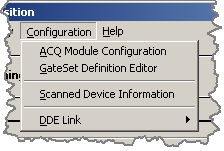
The 'Execute Advisory' submenu items each have an
advisory code number. An external program can control
the acquisition process by using the Dynamic Data Exchange
protocol (DDE). The commands are of the form:
Advisory = #
where # is any valid advisory code number. The DDE link
topic is AcqF.
More information about the DDE option can be found
in the configuration of the DDE Link section.

ACQ Module Configuration
Clicking on the 'ACQ Module Configuration' menu item
opens the 'Acquisition Module Configuration' window:

The configuration window is used to set various module
parameters and enable/disable any of the attached USB ADC
or USB TMR modules. The configuration sections are:
IO Module Chain
The IO Module Chain dropdown box selects a 'chain' of
IO modules (see the section describing IO Modules) to be
presented on the configuration window:

Installed Modules
Each row of the Acquisition Module Configuration window
corresponds to an IO Module belonging to the selected
'Chain'.
The 'Installed Module(s)' section contains:
ID - The IO Module's hardware id number
Serial Number - The IO Module's serial number
Resolution - The IO Module's display resolution
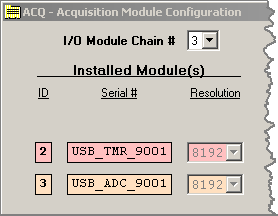
The 'Resolution' dropdown box selects the number of data
channels the raw 8192 channel acquisition data is binned
into.
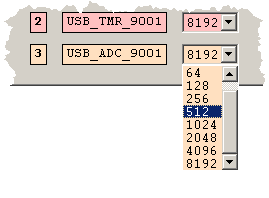
If a resolution of 512 is selected then the raw
ADC data is rebinned so that every 8 channels of the 8192
channel data is combined into 1 channel in the 512 channel
spectrum.
Module Control
The 'Module Control' section contains:
Timer Interval - The timimg interval selection (Timers Only)
MP - Select Multi-Parameter mode
Enable - Enable/Disable the IO Module
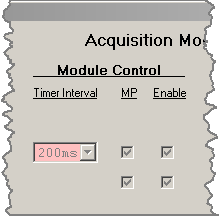
The 'Timer Interval' dropdown selection box is only available
when the IO Module is detected as a timer. The timer intervals
are 100, 200, and 500 microseconds, 1, 2, 5, 10, 20, 50, 100,
200, and 500 milliseconds, and 1, 2, 5, and 10 seconds.
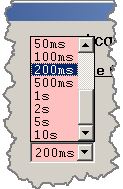
A timer module is used when multi-channel scaling
acquisition is required. Typically a TMR and ADC IO Module
are paired together in a 'Chain' and multi-parameter acquisition is
enabled to create a multi-channel scaling configuration.
The 'MP' check box selects multi-parameter data acquisition
rather than single channel acquisition.
The 'Enable' check box must be checked to activate the
IO Module for data acquisition. An unchecked box disables
this IO Module.
Module Status
The 'Module Status' section contains:
Events/Sec. - The counting rate in events/second
Event Errors - The number of data transfer errors

The 'Events/Sec.' box gives an approximate count rate
for the IO Module. In multi-parameter acquisition all 'MP'
enabled IO modules in the selected chain will show the same
count rate as each 'data event' contains data from every 'MP'
enabled channel.
The 'Event Errors' indicate the number of data
transfer errors encountered during the whole of the
acquisition time for the IO Module. Note that during
multi-parameter acquisition all data is transfered through
the lowest ID module in the chain and errors are reported
only in the lowest ID channel. Typical error rates are
less then 1 per 10^8 events.

GateSet Definition Editor
The editor provides a method to create spectra based
on any or all of the parameters in a chain acquired in
in multi-parameter mode. Parameters may be bound by
low and high limits specified by value or lower and upper
cursor levels selected during acquisition.
Clicking on the 'GateSet Definition Editor' menu item
displays the GateSet Definition Editor.
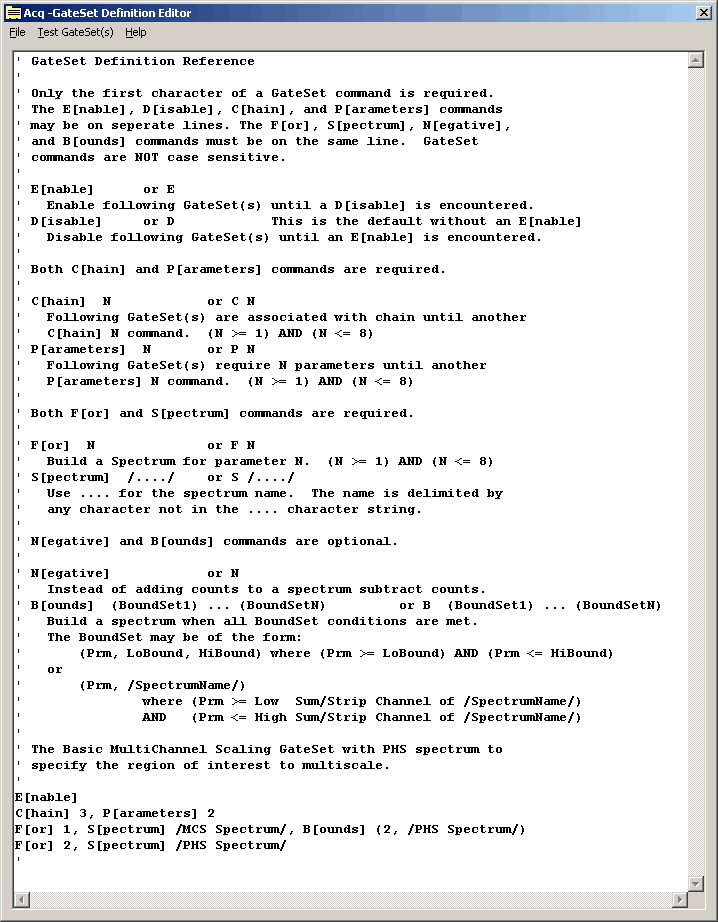
A typical default GateSet definition file is shown. This
text file contains a summary of the commands recognized by
the Gating Set Processor of the ACQ program. The text
editting window supports the common edit commands CTRL C,
CTRL V, and CTRL X plus text selection via the SHIFT and
arrow keys or mouse.
A summary of the gateset commands is shown at the beginning
of the currently loaded gateset definition file. What follows
is a slightly expanded explanation of the commands.
Only the first character of a GateSet command is required.
The Enable, Disable, Chain, and Parameters commands may be
placed on seperate lines. The For, Spectrum, Negative,
and Bounds commands must be on the same line. GateSet
commands are NOT case sensitive and may be abbreviated
to just the first character of the command.
E[nable] or E
Enable the following GateSet(s) until a
D[isable] is encountered.
D[isable] or D
This is the default without an E[nable].
Disable following GateSet(s) until an
E[nable] is encountered.
The C[hain] and P[arameter] commands are
required before the spectrum building commands.
C[hain] N or C N
Following GateSet(s) are associated with
the specified chain until another C[hain]
command. (N >= 1) AND (N <= 8)
P[arameter] N or P N
Where the number of parameters in the associated
IO chain is (N >= 1) AND (N <= 8). The
following GateSet(s) are associated with
the specified parameter count until another
P[arameter] command.
The number N in the following command definitions
refer to Nth parameter in the current IO chain and
not to the device ID of the IO module.
The F[or] and S[pectrum] commands are required
in the gateset definition. N[egative] and B[ounds]
commands are optional.
F[or] N or F N
Build a Spectrum from the Nth parameter
specified in the current IO chain.
Where (N >= 1) AND (N <= parameter count).
S[pectrum] /..../ or S /..../
This command specifies the name of the spectrum
which will be displayed in the ACQ spectrum selection
dropdown box. The .... is used for the spectrum
name. The name is delimited by any character not
in the .... character string.
Negative or N
Instead of adding counts to a spectrum counts
are subtracted.
B[ounds] (BoundSet1) ... (BoundSetN)
or B (BoundSet1) ... (BoundSetN)
Build a spectrum when all BoundSet conditions are met.
The BoundSet may be of the form:
(N, LoBound, HiBound) where the value of
parameter N, NVal, must meet the conditions
(NVal >= LoBound) AND (NVal <= HiBound)
or
(N, /SpectrumName/) where the value of
parameter N, NVal, must meet the conditions
(NVal >= Low Sum/Strip Channel of /SpectrumName/) AND
(NVal <= High Sum/Strip Channel of /SpectrumName/)
The default GateSet file contains the following
gateset commands:
' The Basic MultiChannel Scaling GateSet with PHS spectrum to
' specify the region of interest to multiscale.
E[nable]
C[hain] 3, P[arameters] 2
F[or] 1, S[pectrum] /MCS Spectrum/, B[ounds] (2, /PHS Spectrum/)
F[or] 2, S[pectrum] /PHS Spectrum/
This basic gateset contains all the necessary elements to
create two spectra: an MCS Spectrum (multi-channel scaling)
and a PHS Spectrum (normal pulse-height spectrum).
E[nable] enables the following command lines. The C[hain]
and P[arameter] elements specify chain number 3 having two
parameters. The two following command lines each create a
spectra. The first spectrum created is the /MCS Spectrum/
which is built from parameter 1 (a TMR module) with a bounds
specification for the second parameter (an ADC module).
The upper and lower bounds are from the upper and lower
cursor set points from spectrum /PHS Spectrum/. The
second spectrum created is the /PHS Spectrum/ which is built
from parameter 2 (the ADC module). Note that this spectrum
/PHS Spectrum/, is the spectrum used for the bounds in
spectrum 1 (/MCS Spectrum/).
This gateset is useful for measuring the radioactive decay of
nuclear isotopes. The upper and lower bounds select a
particular radioactive decay from the /PHS Spectrum/ and
an acquisition time interval is selected for the TMR IO Module.
The TMR and ADC are enabled and set for multi-parameter
acquisition. The acquired /MCS Spectrum/ will contain a time
history of the radioactive decay and can be used to easily
find the decay halflife.
GateSet Definition Editor Menu
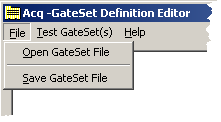
File - Open GateSet File
The 'Open GateSet File' dialog is used to load a new
GateSet definition file:

File - Save GateSet File
The 'Save GateSet File' dialog is used to save the current
GateSet definition file for future use.
Note:
The current contents of the GateSet Editor window will
be saved as file Acq.gst when the ACQ program is
terminated and reloaded when the program is restarted.
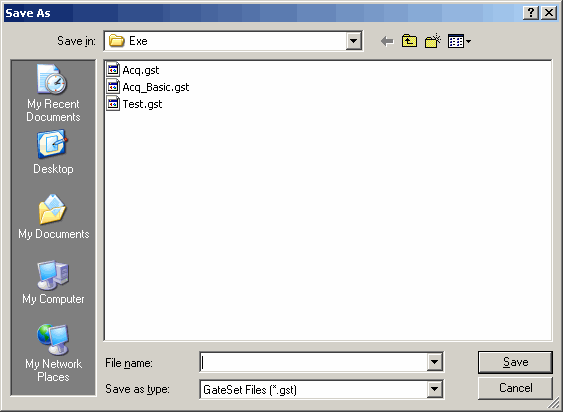
Test GateSet(s)
The 'Test GateSet(s)' option processes the current contents
of the editor checking for simple syntax and parameter errors.
As an example, if the following GateSet is tested
E
C 3, P 2
F 1, S /MCS Spectrum/, B (2, /PHS Spectrum/)
F 3, S /PHS Spectrum/
an error message will be shown:
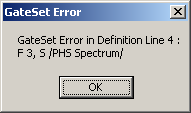
The message simply shows the GateSet line where the
'F 3' is the error. The number of parameters was set to 2.
The ACQ Data Selection Spectrum dropdown box will also
be updated to reflect any enabled, disabled, added, or
removed gateset spectrum names.
Also note that the specification of a spectrum in a
B[ounds] statement that is not built with a corresponding
F[or]/S[pectrum] statement acts as if NO B[ounds] statement
was specified. (ie the bounds will be from 1 to 8192)
Help
Clicking on the 'Help' option opens the Documentation Help
screen at the 'GateSet Definition Editor' for quick access to the
command syntax.

Scanned Device Information
Clicking on the 'Scanned Device Information' menu item
displays the information about the scanned IO modules:
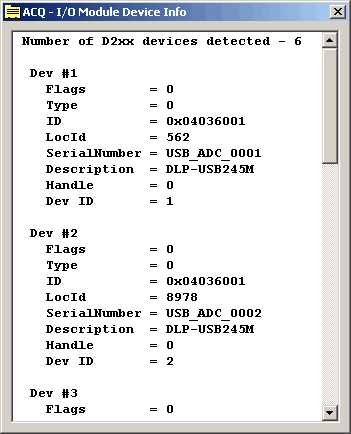
The information is read from the USB device driver and
from the USB IO Module during program initialization.
Scrolling to the end of the information also shows the
'Chain' sequence for the detected IO modules.
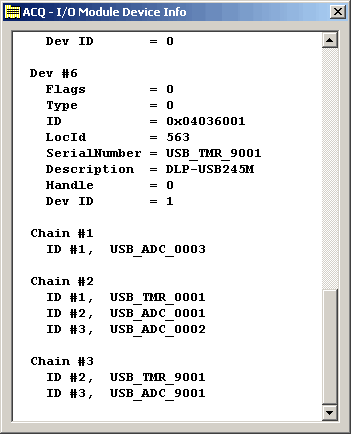

DDE Link
Clicking the 'DDE Link' menu item shows the
DDE Link options:
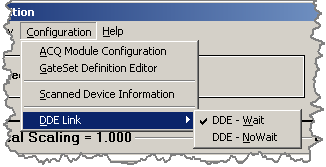
The DDE (Dynamic Data Exchange) Interface can be
configured to:
1) Execute the Advisory and
return at completion (DDE-Wait) or
2) Schedule the Advisory and
return immediately (DDE-NoWait)
Method 1 is the default and recommended
proceedure if the Advisory command requires more
than a few seconds to complete. This ensures that
the calling program will wait for the completion
of the Advisory Command.
If the Advisory takes a very long time,
i.e. greater than 60 seconds, then be sure to
explicitly set the LinkExecuteTimeout value greater
than the longest Advisory execution time.
The DDE interface parameters are:
Program Name: ACQ
Link Topic: AcqF
Count Rate: TbxCntRate
Time: TbxTime
Advisory commands can be sent to ACQ by the
Link Topic AcqF using the following syntax:
Advisor = #
where # is 1 Start Acquisition
2 Stop Acquisition
7 New File
8 Save Data
9 Wait
Refer to the Execute Advisory menu descriptions
for an explanation of each operation.
















